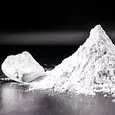Kaolin Clay
Kaolin is primarily composed of kaolinite, an aluminum silicate

WHAT IS
Kaolin Clay?
Kaolin, also known as China Clay, is a soft, earthy mineral with a smooth, powdery texture. Chemically known as Kaolinite (Al2Si2O5(OH4), Covia’s kaolin contains 38 to 39% aluminum. This characteristic makes it a desirable additive for various industrial applications, including ceramics, coatings, in fiberglass aplications in construction,and rubber applications in polymers.
PHYSICAL AND CHEMICAL PROPERTIES
Kaolin, primarily composed of the mineral kaolinite, is a hydrated aluminum silicate formed through the weathering of feldspathic rocks. Its crystal structure consists of stacked layers of one silica tetrahedral sheet (Si-O) and one alumina octahedral sheet (Al-O), with hydrogen bonds holding the layers together. It is usually white or off-white, but impurities can cause kaolin to take on other colors. It is insoluble in water, naturally adsorbent and non-swelling.
Covia’s kaolin products are processed to meet varying specifications, including moisture content and particle size.
WHERE DOES KAOLIN CLAY
Come From?
Kaolin originates from the natural weathering of aluminum-rich rocks like feldspar. This process occurs over millions of years, resulting in the formation of kaolin deposits. In the United States, Georgia is well known for its significant kaolin reserves, located in an east-west band across the state. These deposits formed approximately 70 million years ago during the Cretaceous period when the region was covered by a shallow sea. The quality and characteristics of kaolin can vary depending on its geological origin, influencing its suitability for various industrial applications. Covia has several facilities that process kaolin clay into our portfolio of products:
-
PRESTIGE® Ceramic high-plasticity clay for plastic forming and extrusion, produced in McIntyre, Georgia
-
STARCAST® Ceramic casting kaolin, produced in McIntyre, Georgia and Hephzibah, GA
-
SNOBRITE® Air-floated Kaolin, produced in McIntyre, Georgia
-
ROYALE® and SANDBLEND® Kaolin slurry, produced in Hephzibah, Georgia
-
FG™ Fiberglass grade kaolin, produced in McIntyre, Georgia and Hephzibah, GA
Sustainability
Message
As part of Covia’s partnership with the Wildlife Habitat Council (WHC), our Hephzibah, Georgia location has actively supported bluebird habitat conservation since 2004. Team members manage a bluebird project at the 3,000-acre site, placing nesting boxes in safe, low-traffic areas and preserving portions of the property with native trees and wildlife-friendly grasses. Controlled burns are also conducted to encourage healthy forest growth, promoting the long-term viability of local wildlife.
Would you like to know more about Covia’s silica sand?






